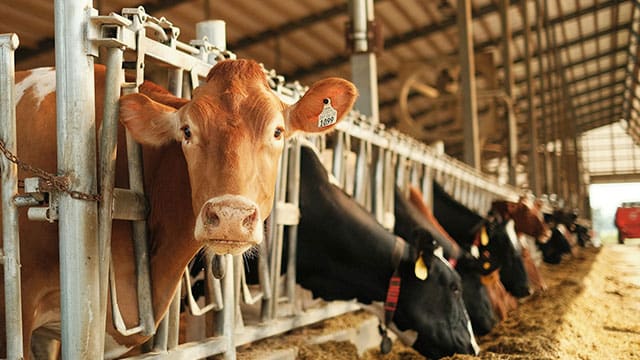Without reform, Canada risks losing nearly half of its dairy farms by 2030, according to experts

For interview requests, click here
Few topics in Canadian agriculture spark as much debate as supply management in the dairy sector. The issue resurfaced when U.S. President Donald Trump criticized Canada’s protectionist stance during NAFTA renegotiations during his first term, highlighting the need to reassess the system’s long-term viability.
Proponents say supply management ensures financial stability for farmers and protects them from global market swings. Critics argue it inflates prices, limits competition and stifles innovation. A policy assessment titled “Supply Management 2.0: A Policy Assessment and a Possible Roadmap for the Canadian Dairy Sector”, conducted by Dalhousie University and the University of Guelph, exposes inefficiencies and presents a compelling case for reform.
Created in the 1970s to regulate production and stabilize prices, Canada’s supply management system uses strict quotas and high import tariffs. However, successive trade agreements such as the USMCA, CETA and CPTPP have eroded these protections. The federal government’s $3-billion compensation package to dairy farmers for hypothetical trade losses underscores the system’s fragility. Instead of building resilience, supply management fosters reliance on government payouts rather than market-driven efficiencies. If current trends persist, Canada could lose nearly half of its dairy farms by 2030—regardless of who is in the White House.
 Is supply management failing us? |
| Recommended |
| Lab-grown animal-free dairy protein a game-changer for dairy industry
|
| Promising probiotic for dairy cattle headed to marketplace
|
| Ottawa tone deaf to issues facing farmers
|
Consumer sentiment is shifting. Younger Canadians are questioning the sustainability and transparency of the dairy industry, particularly after scandals such as ButterGate, where palm oil supplements used in cow feed altered butterfat content, making butter harder at room temperature. Additionally, undisclosed milk dumping of between 600 million and one billion litres annually has further eroded public trust. These factors highlight the industry’s failure to align with evolving consumer expectations.
The policy assessment highlights overcapitalization in the dairy sector. Government compensation payments, coupled with rigid quotas, encourage inefficiency rather than fostering innovation. Unlike their counterparts in Australia and the European Union—where deregulation has driven productivity gains—Canadian dairy farmers remain insulated from competitive pressures that could otherwise drive modernization.
The report also highlights a growing geographic imbalance: over 74 per cent of Canada’s dairy farms are concentrated in Quebec and Ontario, despite only 61 per cent of the national population residing in these provinces. This concentration exacerbates supply chain inefficiencies and increases price disparities. Consumers in Atlantic Canada, the North and Indigenous communities face disproportionately high dairy costs, raising serious food security concerns. Addressing these imbalances requires policies that promote regional diversification in dairy production.
Modernization must include gradual reform of quotas and tariffs. The existing quota system restricts farmers’ ability to respond dynamically to market signals. While quota allocation is managed provincially, harmonizing the system at the federal level would create a more cohesive market. A flexible quota model tied to demand would enhance competitiveness and efficiency.
Tariff policies also warrant reassessment. While tariffs protect domestic producers, they contribute to artificially inflated consumer prices. A phased reduction in tariffs, complemented by direct incentives for farmers investing in productivity-enhancing innovations and sustainability initiatives, could strike a balance between maintaining food sovereignty and fostering competition.
Despite calls for reform, entrenched interests within the sector resist change. Industrial milk prices in Canada are now the highest in the Western world, making the sector increasingly uncompetitive globally. While supply management also governs poultry and eggs, these industries have adapted more effectively through innovation. The dairy sector, however, continues to grapple with structural inefficiencies.
Abolishing supply management outright is neither desirable nor practical. Sudden removal of protections would expose Canadian dairy farmers to aggressive foreign competition, risking rural economic stability and domestic food security. A balanced approach that preserves the core benefits of supply management while integrating market-driven reforms is essential.
Canada’s supply management system, once a pillar of stability, has become an impediment to progress. As global trade dynamics shift and consumer expectations evolve, policymakers have an opportunity to modernize the system. The Supply Management 2.0 recommendations emphasize regional diversification, value-chain-based pricing models aligned with market demand, and a stronger focus on research and development. Performance-based government compensation, rather than blanket payouts that preserve inefficiencies, would improve long-term sustainability.
The question is no longer whether reform is necessary, but whether the dairy industry and policymakers are ready to embrace it. A smarter, more flexible supply management framework is crucial to ensuring Canadian dairy remains resilient, competitive and sustainable for future generations.
Dr. Sylvain Charlebois is a Canadian professor and researcher in food distribution and policy. He is senior director of the Agri-Food Analytics Lab at Dalhousie University and co-host of The Food Professor Podcast. He is frequently cited in the media for his insights on food prices, agricultural trends, and the global food supply chain.
Explore more on Dairy industry, Supply management, Agriculture
The views, opinions, and positions expressed by our columnists and contributors are solely their own and do not necessarily reflect those of our publication.
Troy Media is dedicated to empowering Canadian community news outlets by providing independent, insightful analysis and commentary. Our mission is to support local media in fostering an informed and engaged public by delivering reliable content that strengthens community connections, enriches national conversations, and helps Canadians better understand one another.

